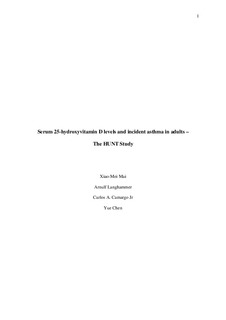| dc.contributor.author | Mai, Xiao-Mei | |
| dc.contributor.author | Langhammer, Arnulf | |
| dc.contributor.author | Camargo, Carlos Arthuro | |
| dc.contributor.author | Chen, Yue | |
| dc.date.accessioned | 2017-06-12T06:55:04Z | |
| dc.date.available | 2017-06-12T06:55:04Z | |
| dc.date.created | 2013-01-11T15:28:09Z | |
| dc.date.issued | 2012 | |
| dc.identifier.citation | American Journal of Epidemiology. 2012, 176 (12), 1169-1176. | nb_NO |
| dc.identifier.issn | 0002-9262 | |
| dc.identifier.uri | http://hdl.handle.net/11250/2445682 | |
| dc.description.abstract | The impact of low vitamin D status on asthma development is unclear. The authors investigated the relation between the baseline serum 25-hydroxyvitamin D (25(OH)D) level and incident asthma in adults, including possible effect modification by allergy status, using allergic rhinitis as a proxy measure. A cohort of 25,616 Norwegian adults aged 19–55 years participated in 2 surveys of the Nord-Trøndelag Health Study known as HUNT 2 (1995–1997) and HUNT 3 (2006–2008). Of this cohort, a nested case-control study included 584 new-onset asthma cases and 1,958 nonasthma controls whose baseline serum 25(OH)D levels were measured. After adjustment for potential asthma risk factors, the baseline serum level of 25(OH)D (<50 nmol/L) was not significantly associated with asthma in either women (adjusted odds ratio = 0.94, 95% confidence interval (CI): 0.67, 1.32) or men (adjusted odds ratio = 1.47, 95% CI: 0.93, 2.32). In men, allergic rhinitis modified the association with the adjusted odds ratio being 0.87 (95% CI: 0.36, 2.06) among men with allergic rhinitis and 2.32 (95% CI: 1.06, 5.10) among men without allergic rhinitis. The serum 25(OH)D level was not associated with incident asthma in women, regardless of allergy status. Low vitamin D status was not significantly associated with incident asthma in most adults, but it may have increased risk among men without allergy. | nb_NO |
| dc.language.iso | eng | nb_NO |
| dc.publisher | Oxford University Press | nb_NO |
| dc.title | Serum 25-Hydroxyvitamin D levels and incident asthma in adults; the HUNT study | nb_NO |
| dc.type | Journal article | nb_NO |
| dc.type | Peer reviewed | nb_NO |
| dc.description.version | acceptedVersion | nb_NO |
| dc.source.pagenumber | 1169-1176 | nb_NO |
| dc.source.volume | 176 | nb_NO |
| dc.source.journal | American Journal of Epidemiology | nb_NO |
| dc.source.issue | 12 | nb_NO |
| dc.identifier.doi | 10.1093/aje/kws235 | |
| dc.identifier.cristin | 986449 | |
| dc.relation.project | Norges forskningsråd: 201895/V50 | nb_NO |
| dc.description.localcode | © The Author 2012. Published by Oxford University Press on behalf of the Johns Hopkins Bloomberg School of Public Health. All rights reserved. For permissions, please e-mail: journals.permissions@oup.com. This is the authors' accepted and refereed manuscript to the article. | nb_NO |
| cristin.unitcode | 194,65,20,0 | |
| cristin.unitname | Institutt for samfunnsmedisin | |
| cristin.ispublished | true | |
| cristin.fulltext | postprint | |
| cristin.qualitycode | 2 | |
